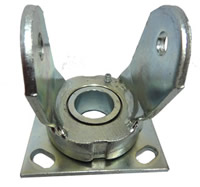Kingpinless casters, as the name suggests, are casters that lack a kingpin. Is this a good thing or a bad thing? What is the purpose of the kingpin, and why would you remove it? Read on to find out.
The kingpin is a feature found in most light to heavy duty swivel casters, though it is generally not used in ultra-light duty casters such as chair casters. It is essentially a rivet, and its job is to hold the top plate and the fork of the caster together, allowing for a ball bearing housing between the two units that in turn allows the caster to swivel properly. The kingpin also tends to be a weak point in situations that put heavy stress on the caster, such as shock loading. In these cases, the kingpin can bend or even break, allowing the ball bearings to fall out and causing caster failure.

The answer to this caster failure is the kingpinless caster. Kingpinless casters are precisely engineered and machined to allow swiveling without a kingpin. The lack of the kingpin removes the casters’ typical weakest link, and provides a casters that can handle shock loading and heavy stress without failure.
Most kingpinless casters are only available at the heavy and extra heavy duty levels of casters, since the easier-to-produce kingpinned casters can handle light and medium duty jobs with ease.
Take a look at kingpinless casters at our online catalog.